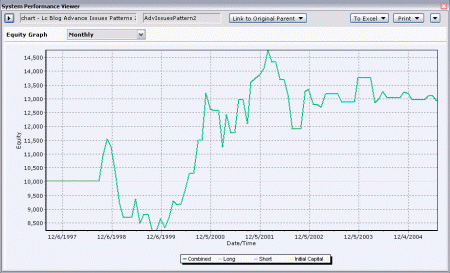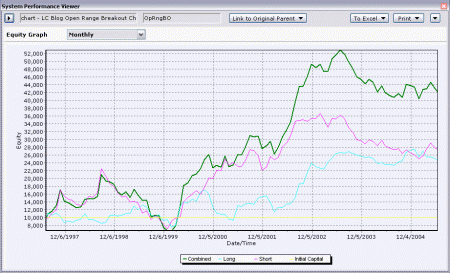The Real Secret of Trend in Day Trading: Finding the Point of No Return
 We often hear traders talking about trend – trend is your friend, do not fight the trend, etc. Yet we seldom hear a room full of traders agree upon what the current trend is. This casual observation leads many people to believe price based analysis (I hate the term technical analysis) is not really that scientific after all. I dare to disagree with the naysayers because they are ignorant of the mechanisms behind trend identification and lack the background knowledge necessary to utilize the information fully.
We often hear traders talking about trend – trend is your friend, do not fight the trend, etc. Yet we seldom hear a room full of traders agree upon what the current trend is. This casual observation leads many people to believe price based analysis (I hate the term technical analysis) is not really that scientific after all. I dare to disagree with the naysayers because they are ignorant of the mechanisms behind trend identification and lack the background knowledge necessary to utilize the information fully.
Trend Is a Precisely Defined Term
For non-traders or beginner traders, they often confuse that trend is a big picture thing. No, it is not. Trend in day trading is a highly precise term describing specific market conditions for the trader’s primary timeframe. In other words, what every trader have in their minds about the trend that they refer to are different from the others.
Hence, before two traders can have a healthy discussion of the current market conditions, or, a group of traders can have a sentiment survey of the mood of the market, the background conditions have to be defined first. For example, on daily timeframe, with short term swing trend as the trend identification method, the current trend is well defined.
Classic Trend Play
Discretionary day traders often think of themselves as counter-trend traders who pick the bottoms and fade the tops. In reality, most of their trades that work out well are the ones that is in line with the higher timeframe trend conditions. The more experienced day traders are aware of this and often use a higher timeframe trend filter to improve their odds.
The difficulty in using a trend filter is that many potentially profitable trades will be filtered out too. This can lead to frustrations for beginner traders as they see the opportunities are slipping away. Well, one should remember that the really bad ones are also removed and that is the purpose of having a trend filter in the first place.
Chart traders who use basic chart patterns are often trend traders without know about it. For example, if you try to buy a bull flag developing in 15-minute that looks like bottoming on your primary timeframe of 5-min, you are trading the trend that affect you most.
Mechanical Trend Play
It is well known that mechanical traders often trade the pullbacks to specific moving averages or the breakout of tight range. Both approaches are again leaning on the trend in the higher timeframe. Hence basic day trading models can often do much better with a simple trend filter from the higher timeframes.
Beginner trading system developers often use longer period moving averages or other technical indicators as their trend filter which is counter productive. Remember trading is a game of incomplete information. Hence you need to really look at the higher timeframe data because you are trying to gauge what the higher timeframe players are trying to do. One good higher timeframe filter can replace all the complex rules you probably introduced into the systems to curve fit for profitability.
The All Powerful Point of No Return
Point of No Return is an interesting name introduced to me by one of my mentors. In short, majority of the time when we are day trading, we are trading the noise in the eyes of the daily and higher timeframe traders. But, when certain price levels are breached, these higher timeframe players will be forced to react during the trading day. In other words, suddenly, the delicate liquidity balance is broken where everyone who has committed positions are affected.
Once the Point of No Return is reached, as the name suggested, the market will continue to move in the same direction until the end of the trading session. At this point many will say it is simply a breakout setup then. That is partially correct. It is a breakout setup but it is not a breakout coming from your own day trading intraday timeframes.
This type of breakout moves do not happen often but they are very profitable if you correctly identify them beforehand. You can also think of them as your safeguard when you are trying counter-trend play to pick tops and bottoms during the day. By knowing where the point of no return price levels are, you know when to fold your counter-trend plays and save a lot of money.
Identification of Point of No Return Depends on the Specific Market
As every markets are different due to the difference in the behaviour of the participants, the point of no return price levels do not come from one set of magic formulas that can be applied to all the markets. Instead, it depends on the statistical characteristics of each individual markets.
For example, Emini S&P has a very different statistical behaviour even comparing to its cousin Emini Nasdaq 100. S&P500 is famous for its mean reverting behaviour on intraday basis while NDX have more directional intraday swings. Hence the point of no return price levels for them cannot be calculated the same way.
Another good example is crude oil. For those who day trade crude, you must have noticed from time to time, crude just jump and dash towards a far away price level in an almost straight line move all day. Crude has this tendency because it has more active higher timeframe players than the Emini index futures. Hence the higher timeframe players have more influence on this market on intraday basis.
Summary
As a day trader, we spend all our time to study the price behaviours on intraday data. That already keeps many of us very busy everyday. Yet, by taking a step back and look at the bigger picture from the perspective of the higher timeframe players, there are very useful information for which we can take advantage of as day traders. The point of no return concept is one of those trading secrets that can help day traders to improve their game significantly.
Remember a sound driver of trading bias comes from logical concepts that are not based on data mining alone. Knowing the reason behind is more important than twisting the parameters. When you have clarity in your trading plan why you choose certain strategies over another, you will more likely stick to it with better executions. A magical trading model where you have no idea how that works will not help you as you will eventually loose your confidence in the model.
End Notes
I am wrapping up a set of day trading models to be published. My assistant who is helping me to verify the results told me he is very confused why these models work at all. Suddenly I realize it is important to at least write a short introduction about the point of no return concept as it is the foundation for many of these models.













You’ve whet my appetite for those day trading models. As you know my current trading style, recognizing higher timeframe overrides of otherwise good countertrend scalping trades is critical information. Was today 8/17/15, such a day, as I was steamrolled?
Yes i believe 8/17/2015 perfect example of this concept. Perhaps LC can elaborate why. iMO 15min chart shows. Monday It stalled ahead of a key lvl that was defended last week thursday friday. Its farily obvious long term players are forcing these moves at key lvls and squeezing shorts completely